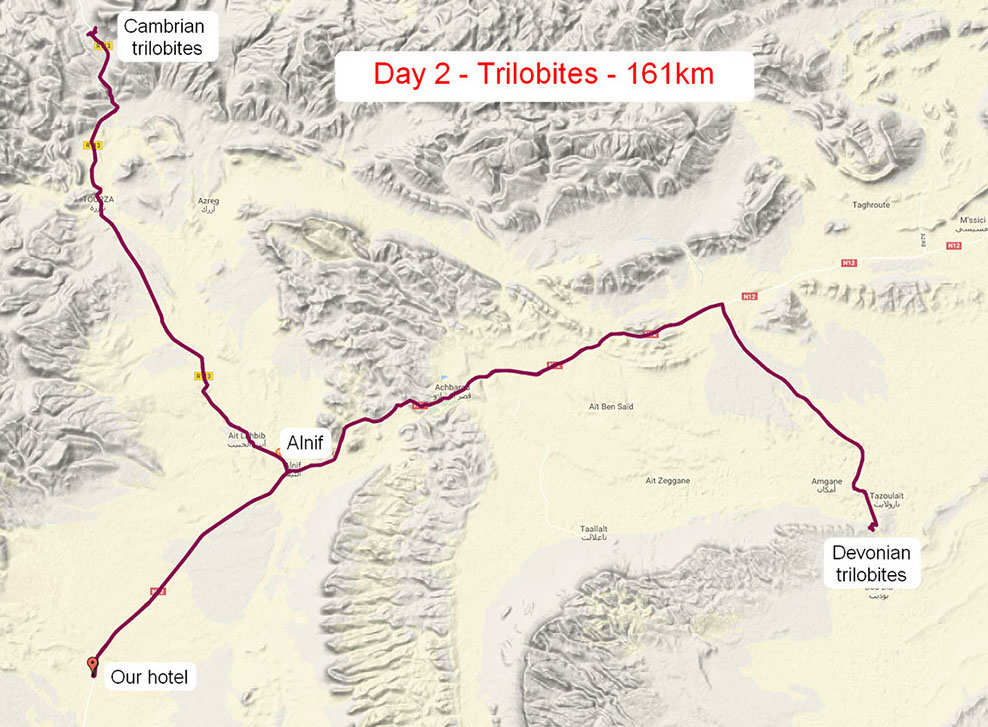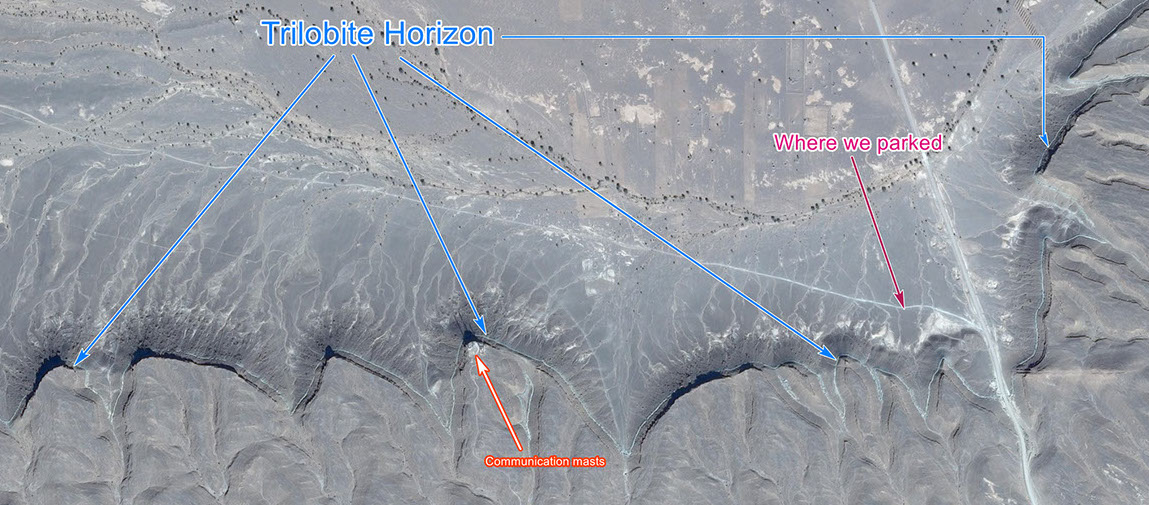Day 2 - Tuesday 3rd April 2018
This day started and finished in the Meteorites Hotel 12 km south west of Alnif. We spent a short time in Alnif to acquaint ourselves with where the fossil shops were, but most of the time was at the trilobite diggings - the Devonian ones in the morning and the Cambrian ones in the afternoon.

We drove about 40 km from Alnif to the Devonian trilobite excavations. Although most of the Devonian succession here is fossiliferous, one particular horizon is of interest to the fossil hunters and this must make it one of the longest quarries in the world. It shows up particularly well on Google maps.

The trilobite excavations are, so far, surface diggings. I presume that with time they will advance further into the hillside.
Prof. Martill writes in the trip handbook:-
After looking at the fossil shops in Alnif, we will drive east and then detour south towards Fezzou
where we will examine strata (the Devonian lssoumour beds) that yield the trilobites. The Jbel
lssoumour of the Saharan Atlas is World famous for its Devonian trilobites. Many other fossils can
be found here too, including crinoids and goniatites.
They trilobites are preserved complete and in 3D. Local collectors have quarried almost the entire
outcrop. Highly skilled preparators develop the fossils and sell them all over the World . There
are several shops in Alnif, where prices are considerably cheaper than those you may see on the
internet. We will visit the main collecting localities to the east of Alnif along the road to
Fezzou.
Which sums up what we did.
You can see the waste from the trilobite horizon near the top of the slope. It has a slightly blue tinge.
In the excavation - where there used to be trilobites.
The "good" fossils are found in concretions. When a concretion is found, it is broken and if a fossil is found, it is put back together so that the fossil will not be damaged. It is taken to the preparator who, if he agrees with the finder that it is worth preparing, glues it back together, excavates the trilobite and puts it up for sale. I presume that at some stage in this process money changes hands.
As you will see from some of tomorrows photos, preparing is a very skilled job requiring manual dexterity and, at the least, working out which way up the trilobite is - where is the top of the fossil. And whether to expect spines and other distinctive features.
A more distant view of the trilobite excavations.
I found a few fragments of trilobite which were enough to keep interest alive but nothing spectacular. And no concretions were seen. Photos of some of my fragments are seen below.
Our mini-buses parked beneath the trilobite bearing slopes
After a few hours of fossil hunting, when everyone had their fill and some had decent finds, we set off for our picnic lunch and then back through Alnif to the Cambrian trilobite locality.
This is a much smaller operation than that of the Devonian trilobites. The bit we saw was a one man operation, done when there was nothing to be done on his "farm". The Cambrian rocks are harder and sharper, making excavation more difficult. And the fossils are not found in nodules.
Meeting the farmer/fossilist and his family demonstrated the difficulty of making a living in this harsh desert. But this man seemed to be making a good job of his circumstances. He had a solar powered pump to get water from a borehole and was using it to irrigate small patches cleared in the pebbly soil, growing beans, barley and other green stuff as well as a few date palms.
The solar panel powering a submersible pump in a borehole (on the right). He has managed to turn parts of this inhospitable landscape green.
We then returned to the Meteorite Hotel and the benefits of western tourism.
In the garden of the Meteorite Hotel - above
and
The swimming pool of the Meteorite Hotel - below
Introduction
Arrival
Day 1
Day 2
Day 3
Day 4
Day 5
Day 6













